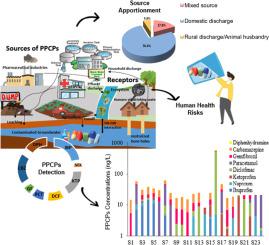Science of the Total Environment ( IF 9.8 ) Pub Date : 2021-10-15 , DOI: 10.1016/j.scitotenv.2021.151010 Hudda Khaleeq Khan 1 , Muhammad Yasir Abdur Rehman 1 , Muhammad Junaid 2 , Ming Lv 2 , Linxia Yue 2 , Ihsan-Ul Haq 3 , Nan Xu 2 , Riffat Naseem Malik 1

|
Background
Pharmaceuticals and personal care products (PPCPs) are emerging contaminants that have been extensively used in present time to improve the living standards. Their persistence in water resources due to various anthropogenic sources such as wastewater treatment plants, pharmaceutical industries, and runoff from agricultural and livestock farms has not only threaten aquatic life but their occurrence in groundwater has also raised concerns related to humans' wellbeing.
Methods
Considering this as a neglected area of research in Pakistan, a systematic monitoring study was designed to investigate their occurrence, sources, and potential environmental and human health risks in groundwater from urban-rural areas of six cities. Ultra-High-Performance Liquid Chromatography-Tandem Mass Spectrometry (UHPLC-MS/MS) was used to analyze the collected samples preceded by solid-phase extraction.
Results
Overall, 8 out of 11 selected PPCPs were detected in groundwater samples with detection frequency ranging from 5.5–65%. Their concentrations ranged from below limit of detection (<LOD) to 1961 ng/L. The overall mean concentrations of detected PPCPs were found below 100 ng/L. The highest mean concentration was reported for Ibuprofen (154 ng/L) in Rawalpindi/Islamabad. Results of PCA-MLR revealed that domestic wastewater discharge (76.4%) was the dominant source contributing to PPCPs contamination in groundwater. Followed by mixed source (pharmaceutical & hospital waste) 17.8%, and rural discharge/animal husbandry 5.8%. No appreciable risk to human health upon exposure to detected PPCPs via drinking water was anticipated. However, environmental risk assessment indicated moderate risk posed to P. subcapitata (RQ = 0.98) and D. magna (RQ = 0.2) by ibuprofen.
Conclusion
The current study reports the first evidence of PPCPs occurrence in groundwater in Pakistan. Reporting their occurrence in groundwater is a fundamental initial step to inform public-health decisions concerning sewage systems and drinking water quality. Hence, comprehensive monitoring programs are required to further investigate contamination of emerging contaminants in groundwater and their associated risks.
中文翻译:

巴基斯坦主要城乡环境中用作饮用水源的地下水中选定 PPCPs 的发生、来源分配和潜在风险
背景
药品和个人护理产品 (PPCP) 是新出现的污染物,目前已被广泛用于提高生活水平。由于各种人为来源,如污水处理厂、制药业以及农业和畜牧场的径流,它们在水资源中的持续存在不仅威胁着水生生物,而且它们在地下水中的存在也引起了与人类福祉相关的担忧。
方法
考虑到这是巴基斯坦被忽视的研究领域,设计了一项系统的监测研究,以调查其在六个城市城乡地区地下水中的发生、来源以及潜在的环境和人类健康风险。使用超高效液相色谱-串联质谱 (UHPLC-MS/MS) 分析收集的样品,然后进行固相萃取。
结果
总体而言,11 种选定的 PPCP 中有 8 种在地下水样本中被检测到,检测频率范围为 5.5-65%。它们的浓度范围从低于检测限 (<LOD) 到 1961 ng/L。检测到的 PPCP 的总体平均浓度低于 100 ng/L。据报道,拉瓦尔品第/伊斯兰堡的布洛芬平均浓度最高 (154 ng/L)。PCA-MLR 的结果显示,生活污水排放(76.4%)是导致地下水中 PPCPs 污染的主要来源。其次是混合来源(医药和医院垃圾)17.8%,农村排放/畜牧业5.8%。预计通过饮用水接触检测到的 PPCP 不会对人类健康造成明显风险。然而,环境风险评估表明对P. subcapitata构成中等风险(RQ = 0.98) 和D. magna (RQ = 0.2) 布洛芬。
结论
目前的研究报告了巴基斯坦地下水中存在 PPCPs 的第一个证据。报告它们在地下水中的发生是为有关污水系统和饮用水质量的公共卫生决策提供信息的基本第一步。因此,需要全面的监测计划来进一步调查地下水中新兴污染物的污染及其相关风险。



























 京公网安备 11010802027423号
京公网安备 11010802027423号